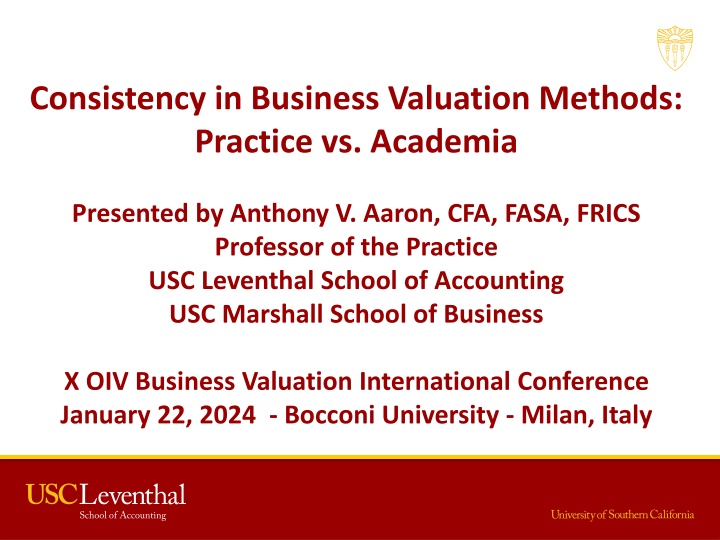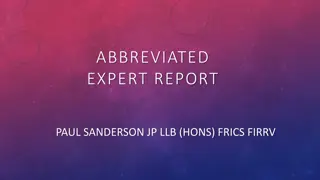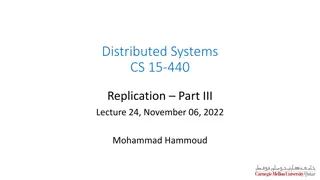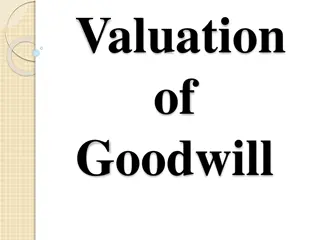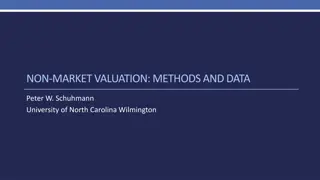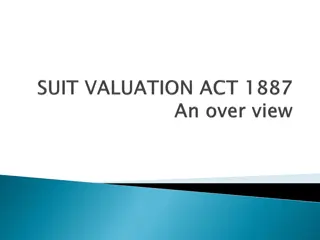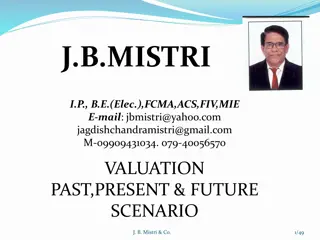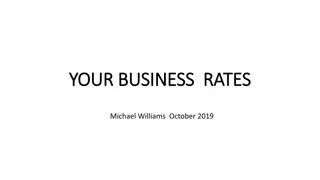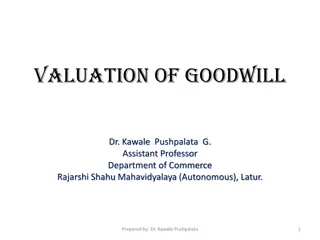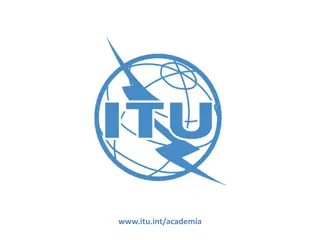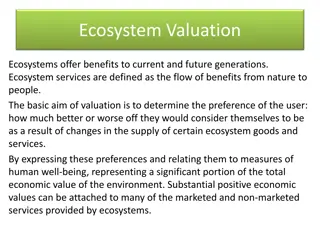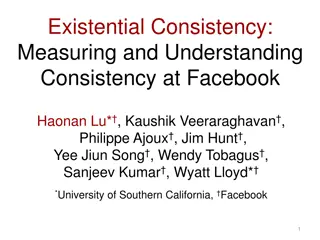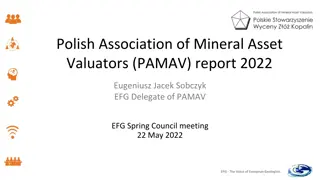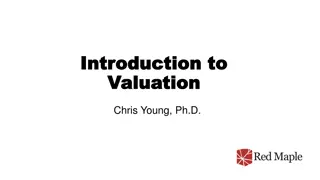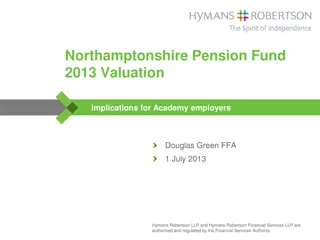Consistency in Business Valuation Methods: Practice vs. Academia
This presentation by Anthony V. Aaron discusses the differences between business valuation methods as practiced in professional settings versus academia, focusing on the income, market, and cost approaches. Differences in emphasis and methodology are explored, with insights on the income approach, forecasts, market approach, cost of capital, and more.
Download Presentation

Please find below an Image/Link to download the presentation.
The content on the website is provided AS IS for your information and personal use only. It may not be sold, licensed, or shared on other websites without obtaining consent from the author.If you encounter any issues during the download, it is possible that the publisher has removed the file from their server.
You are allowed to download the files provided on this website for personal or commercial use, subject to the condition that they are used lawfully. All files are the property of their respective owners.
The content on the website is provided AS IS for your information and personal use only. It may not be sold, licensed, or shared on other websites without obtaining consent from the author.
E N D
Presentation Transcript
Consistency in Business Valuation Methods: Practice vs. Academia Presented by Anthony V. Aaron, CFA, FASA, FRICS Professor of the Practice USC Leventhal School of Accounting USC Marshall School of Business X OIV Business Valuation International Conference January 22, 2024 - Bocconi University - Milan, Italy
Disclaimer: This presentation solely represents the views of the speaker and does not represent the official views of the leadership, faculty or staff of the USC Leventhal School of Accounting or the USC Marshall School of Business, or of any other academic, governmental or professional organization.
Todays Topics I. Business valuation as practiced in the professional setting Business valuation as described in academic texts and as taught in the academic setting III. Differences in emphasis and methodology I. The Income Approach II. Forecasts III. The Market Approach IV. Cost of Capital IV. Summary and Conclusion V. Questions II.
Business Valuation as Practiced in the Professional Setting
Business Valuation as Practiced in the Professional Setting US Valuation practitioners ( USVPs ) commonly consider the Income, Market and Cost approaches in performing a business valuation. Income Approach: USVPs commonly utilize a Discounted Cash Flow ( DCF ) method under the income approach to measure the value of a business entity. Such methods are most often applied on an unleveraged basis. In order to value equity, the value of debt is subtracted to arrive at equity value. Adjustments may be made for non-operating assets, or super-adequate or insufficient working capital and/or P,P&E. For DFNWC, adjustments may take the form of adding/subtracting differences between assumed levels and actual levels of DFNWC utilized at the beginning of year one of a forecast period. If valuing non-controlling interests, certain discounts may be applied to the equity value if the DCF method is prepared on a control basis.
Business Valuation as Practiced in the Professional Setting (continued) Market Approach: USVPs commonly utilize a public company comparison method and an M&A Transaction comparison method under the market approach. Such methods can be applied on both a leveraged basis and an unleveraged basis, depending on the market multiples and performance metrics utilized. Sometimes, USVPs will derive multiples net of cash , apply those multiples to the subject entity s metrics, and then add back the subject entity s cash balance to avoid distortions due to differing cash levels among the peer group.
Business Valuation as Practiced in the Professional Setting (continued) Market Approach (continued): If unleveraged, in order to value equity, the value of debt is subtracted to arrive at equity value. If leveraged, in order to value the overall entity, the value of debt is added to arrive at entity value. Adjustments may be made for non-operating assets, or super-adequate or insufficient working capital and/or P,P&E. If valuing non-controlling interests, certain discounts may be applied to the equity value if it has been prepared on a control basis.
Business Valuation as Practiced in the Professional Setting (continued) Cost Approach: USVPs do not commonly utilize methods under the cost approach to value operating entities. Such methods for business entities, when applied, are often referred to broadly as summation methods . Examples of specific method names include sum-of- the-parts , adjusted balance sheet , adjusted net assets and net asset value (NAV) . Circumstances where the cost approach might be appropriate include: Asset intensive entities Entitles in liquidation or close to being liquidated Investment or holding companies
Business Valuation as Practiced in the Professional Setting (continued) Weighting of Valuation Indications: USVPs will often weight the indications resulting from the application of multiple methods. A common quantitative starting point for the weighting of multiple valuation indications is a 50%/50% weighting of the results of the Income and Market Approaches. If both public company and M&A transactions methods are used under the market approach, some USVPs might initially weight the results of each at 25% per method, while the results of the DCF method is weighted at 50%. Others might initially weight each method at 33%/33%/33%, respectively. From an initial starting point, weightings might be adjusted by USVPs for the level of confidence the USVP places on the inputs and results of each method. Sometimes, USVPs will use a more qualitative approach to weighting, or simply select the results of a single method as being most representative of value.
Business valuation as Described in Academic Texts and as Taught in the Academic Setting
Business Valuation as Described in Academic Texts and as Taught in the Academic Setting Academic Texts and University Instructors ( ATUIs ) commonly focus on the Income Approach in the illustration of business valuation. Income Approach: While some ATUIs might describe a Discounted Cash Flow ( DCF ) method under the income approach similar to that utilized by USVPs, most appear to emphasize methods that are often described or entitled Residual Operating Income ( ROPI ) models (Other names for this family of methods might include Excess Income or Economic Income models). Such methods are typically applied on an unleveraged basis, but using a somewhat different thought process. ROPI models value the entity using earnings rather than cash flows. Also, value is calculated by added the book value of Net Operating Assets ( NOAs ) to the present value of forecasted residual income , excess income or economic income .
Business Valuation as Described in Academic Texts and as Taught in the Academic Setting (continued) Income Approach (continued): Assets and liabilities are classified as operating and non-operating. Non- operating assets are netted against non-operating liabilities to produce net non-operating obligations . The operating enterprise is valued based on NOPAT and net non-operating obligations are deducted to arrive at equity value. One major difference is the treatment of cash. In applying a DCF model, USVPs will often deduct an estimate of Debt Free Net Working Capital ( DFNWC ) from NOPAT (which includes transactional cash) while in the construct of ROPI models, all cash is generally viewed as a non-operating asset. Mechanical Observation: USVPs tend to use mid-period discounting, while ATUIs tend to use end-of-period discounting.
Differences in Emphasis and Methodology
Differences in Emphasis and Methodology Income Approach: Use of DCF (USVPs) vs. ROPI (ATUIs) (discussed earlier) Use of forecasts prepared by others (USVPs) vs. preparation of integrated income statement, balance sheet, SOCFs forecasts (ATUIs). Consideration of cash Is a transactional balance of cash an operating asset (USVP common practice), or is all cash non- operating (ATUI suggested approach)?
Differences in Emphasis and Methodology (Continued) Income Approach Free Cash Flow Calculation: USVPs often use the following formula for calculating normalized forecasts of free cash flow: Forecasted NOPAT (Net Operating Profit After Tax) Plus: Forecasted Depreciation and Amortization (smoothed based on averages) Less (Plus): Forecasted Changes in DFNWC* (smoothed based on averages) Less: Forecasted CAPEX (Capital Expenditures -smoothed based on averages) Equals: Forecasted Free Cash Flows *DFNWC: Debt Free Net Working Capital = Current Assets Debt Free Current Liabilities Debt Free Current Liabilities = Current Liabilities Short term interest-bearing debt
Differences in Emphasis and Methodology (Continued) Income Approach Free Cash Flow Calculation: ATUIs often use the following formula for calculating normalized forecasts of free cash flow: Free Cash Flow = NOPAT Increase in Net Operating Assets Similar to USVPs concept, only stated differently, although transactional cash is not included in this equation if it is not included in Net Operating Assets. Not including the need for increases in transactional cash would tend to overstate value relative to the USVPs approach. While net debt subtracted from entity value is lower due to including all cash in non-operating assets, this is offset by NOA being lower by the same amount. However, since the WACC times NOA is also lower, the present value of residual income would be higher and again, tend to overstate value relative to the USVPs approach.
Differences in Emphasis and Methodology (Continued) Forecasts: USVPs often utilize forecasts provided by others ATUIs. In doing so, however, they review or stress test the forecasts to insure that they represent an unbiased view of future expectations. If not, USVPs will suggest forecast modifications to management, or consider using a different discount rate (discount rate adjustment technique) or down-weight the results of the DCF method in coming to an estimate of value. ATUIs suggest the preparation of forecasts from scratch, however, at times using assumptions that may tend to oversimplify views of the future (my observation).
Differences in Emphasis and Methodology (Continued) The Market Approach: USVPs typically employ a robust market approach, using both public company market multiples and M&A transaction multiples (when available). USVPs commonly apply many different multiples, both on a leveraged and unleveraged basis. Examples include: Leveraged P/E Price to Revenue Price to Book: Unleveraged TEV/EBITDA TEV/EBIT TEV/Revenue TEV to BV of IC
Differences in Emphasis and Methodology (Continued) The Market Approach (Continued): USVPs will screen for peer companies based on quantitative and qualitative similarities. USVPs may weight the value indications from individual peer companies by comparability, rather than just using a simple average or median. USVPs may further weight the value indications from each multiple based on the relevance and the quality and comparability of the financial metric underlying the use of each multiple, rather than just using a simple average or median. USVPs consider judgement and experience to be crucial in applying the market approach.
Differences in Emphasis and Methodology (Continued) The Market Approach (Continued): ATUIs appear to commonly consider the market approach to be secondary to the Income Approach (my observation). ATUIs typically illustrate the use of the market approach using a single multiple, such as a Price to Earnings multiple. ATUIs often use a single peer company, or perhaps a small number of peer companies. ATUIs often use simple averages or medians of multiples between peer companies and among multiples applied (if more than just the P/E ratio). Little analysis is typically attached to the market approach by ATUIs. The approach is often viewed as being too subjective or simply confirmatory to the results of the income approach. My observation: ATUIs put little weight on the market approach because they are uncomfortable with the judgement associated with its application!
Differences in Emphasis and Methodology (Continued) Cost of Capital: Possible differences in cost of capital analysis: Unleveraging and re-leveraging Betas (Hamada Equation*) Use of industry average Betas Use of adjusted (mean-reversion) Betas Synthetic risk free rate (based on historical averages) vs. Spot rates Use of models other than CAPM for cost of equity (MFM/APT) Equity Risk premium as a spread (expected equity return spot rate) vs. as a historical average My observations regarding common misapplication: use of spot risk free rates with historical averages of equity premiums (use of today s spread would be more appropriate: my view), or use of synthetic risk free rates with today s spread (use of historical average would be more appropriate: my view). * L = U * [1+(1 T) * (E/D )]
Summary and Conclusion I. USVPs of business valuation often prepare their analyses using a variety of methods which they weight in accordance with professional judgement and experience in arriving at their conclusions. ATUIs often emphasize solely the income approach, particularly in the form of a residual operating income method. USVPs often utilize forecasts provided by others, while ATUIs tend to suggest the preparation of forecasts from scratch, at times using assumptions that may tend to oversimplify views of the future. USVPs often estimate Cost of Capital using WACC at the entity level and an adjusted CAPM at the equity level. ATUIs often suggest similar methods, but suggest other cost of equity models (such as the Fama-French multi factor model or the APT). ATUIs my also suggest the application of other techniques, such as the use of industry betas and synthetic risk free rates. II. III. IV.
